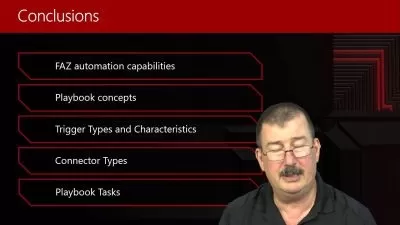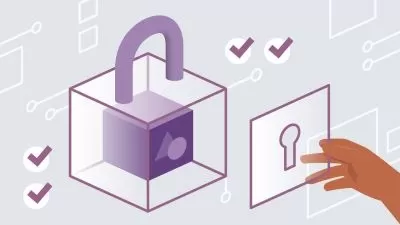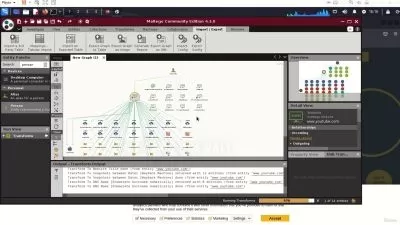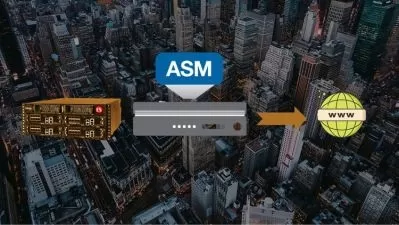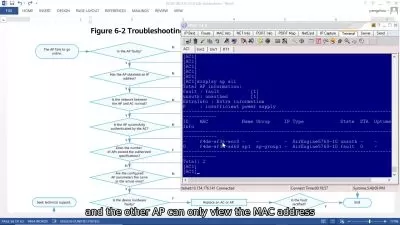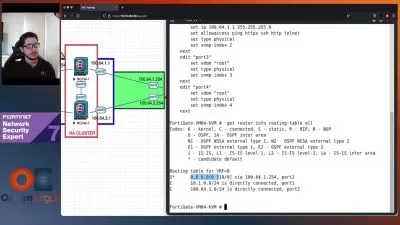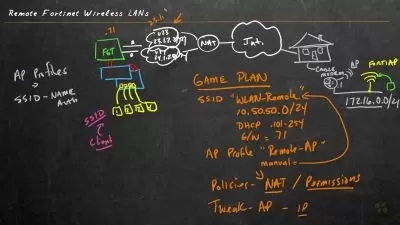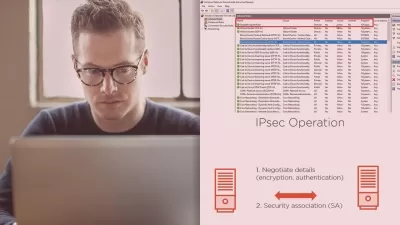Palo Alto Firewall Version 11 Essentials Training
Ahmad Ali
9:45:33
Description
Learn Palo Alto Firewall PAN-OS Version 11 with Step-by-Step Lab Workbook
What You'll Learn?
- Install and configure new Palo Alto Networks Next-Generation Firewalls.
- Manage the Palo Alto Next-generation Firewall’s configurations.
- Configure the Firewall to connect to your production network.
- Manage the Security Policy Rules used to protect your network.
- Manage Network Address Translation (NAT) Rules.
- Configure and manage Palo Alto Networks next-generation firewalls.
- Configuring, managing, and monitoring a firewall in a lab environment.
- Configure & manage essential features of Palo Alto next-generation firewalls.
- Configure and manage Security and NAT policies.
- Configure and manage Threat Prevention strategies to block traffic.
- Configure Policy based on application (App-ID) and user identity (User-ID).
- Configure SSL Decryption on Firewall to inspect & control decrypted sessions.
- Monitor network traffic using the interactive web interface and firewall reports.
Who is this for?
What You Need to Know?
More details
DescriptionCourse Overview:
Successful completion of this course should enhance the student’s understanding of how to configure and manage Palo Alto Networks next-generation firewalls. The student should learn and get hands-on experience configuring, managing, and monitoring a firewall in a lab environment. The Firewall Configuration and Management (PAN EDU 210) course covers all the content required for the PCNSA Palo Alto Networks Certified Network Security Administrator certification.
EDU-210 Course Description:
This training is the most important course as it covers all the fundamentals to understand the Next-Generation Firewall from the ground up. Even experienced firewall engineers take a lot out of this course as it includes, besides the architecture and management essentials, topics like Application Identification, Content ID (IPS, Anti-Virus/-Spyware, URL Filtering, File Blocking), SSL Decryption and User Identification which are all features usually not supported by legacy firewalls.
Outline:
01. Introduction and Initial Configuration
02. Palo Alto Architecture
03. Configuring Initial Firewall Settings
04. Managing Firewall Configurations
05. Interface Configuration
06. Managing Firewall Administrator Accounts
07. Connecting Firewall to Production Networks
08. Security Zones
09. Creating and Managing Security Policy Rules
10. Creating and Managing NAT Policy Rules
11. App-ID (Application Identity)
12. Security Profiles
13. URL Filtering
14. WildFire
15. User-ID (User Identity)
16. Encryption and Decryption
17. Monitoring and Reporting
Product Versions:
Palo Alto Firewall PAN-OS Version 11.0.0
Objectives:
After completing this course, you should be able to:
o Install and configure new Palo Alto Networks Next-Generation Firewalls.
o Manage the Palo Alto Next-generation Firewall’s configurations.
o Configure the Firewall to connect to your production network.
o Manage the Security Policy Rules used to protect your network.
o Manage Network Address Translation (NAT) Rules.
o Configure and manage Palo Alto Networks next-generation firewalls.
o Configuring, managing, and monitoring a firewall in a lab environment.
o Configure & manage essential features of Palo Alto next-generation firewalls.
o Configure and manage Security and NAT policies to enable approved.
o Configure and manage Threat Prevention strategies to block traffic.
o Configure Policy based on application (App-ID) and user identity (User-ID).
o Configure SSL Decryption on Firewall to inspect & control decrypted sessions.
o Monitor network traffic using the interactive web interface and firewall reports.
Prerequisites:
Students must be familiar with networking concepts, including routing, switching, and IP addressing. Students also should be familiar with basic security concepts. Experience with other security technologies (IPS, proxy, and content filtering) is a plus.
Lab Images:
Palo Alto Firewall: Paloalto-11.0.0
Palo Alto Panorama: Panorama-11.1.0
Cisco Switches: i86bi_linux_l2-ipbasek9-ms.high_iron_aug9_2017b.bin
Windows 11:Â Windows 11-x64-SE
Windows Server 2016: Winserver-S2016-R2-x64
Multiple WAN: Pfsense-2.6.0
Clients: Linux-slax-9.11.0
Web Servers: Linux-tinycore-6.4
Internet Link: NAT Cloud or Management Cloud
Who this course is for:
- Security Engineers
- Security Administrators
- Security Operations Specialists
- Security Analysts
- Support Staff
Course Overview:
Successful completion of this course should enhance the student’s understanding of how to configure and manage Palo Alto Networks next-generation firewalls. The student should learn and get hands-on experience configuring, managing, and monitoring a firewall in a lab environment. The Firewall Configuration and Management (PAN EDU 210) course covers all the content required for the PCNSA Palo Alto Networks Certified Network Security Administrator certification.
EDU-210 Course Description:
This training is the most important course as it covers all the fundamentals to understand the Next-Generation Firewall from the ground up. Even experienced firewall engineers take a lot out of this course as it includes, besides the architecture and management essentials, topics like Application Identification, Content ID (IPS, Anti-Virus/-Spyware, URL Filtering, File Blocking), SSL Decryption and User Identification which are all features usually not supported by legacy firewalls.
Outline:
01. Introduction and Initial Configuration
02. Palo Alto Architecture
03. Configuring Initial Firewall Settings
04. Managing Firewall Configurations
05. Interface Configuration
06. Managing Firewall Administrator Accounts
07. Connecting Firewall to Production Networks
08. Security Zones
09. Creating and Managing Security Policy Rules
10. Creating and Managing NAT Policy Rules
11. App-ID (Application Identity)
12. Security Profiles
13. URL Filtering
14. WildFire
15. User-ID (User Identity)
16. Encryption and Decryption
17. Monitoring and Reporting
Product Versions:
Palo Alto Firewall PAN-OS Version 11.0.0
Objectives:
After completing this course, you should be able to:
o Install and configure new Palo Alto Networks Next-Generation Firewalls.
o Manage the Palo Alto Next-generation Firewall’s configurations.
o Configure the Firewall to connect to your production network.
o Manage the Security Policy Rules used to protect your network.
o Manage Network Address Translation (NAT) Rules.
o Configure and manage Palo Alto Networks next-generation firewalls.
o Configuring, managing, and monitoring a firewall in a lab environment.
o Configure & manage essential features of Palo Alto next-generation firewalls.
o Configure and manage Security and NAT policies to enable approved.
o Configure and manage Threat Prevention strategies to block traffic.
o Configure Policy based on application (App-ID) and user identity (User-ID).
o Configure SSL Decryption on Firewall to inspect & control decrypted sessions.
o Monitor network traffic using the interactive web interface and firewall reports.
Prerequisites:
Students must be familiar with networking concepts, including routing, switching, and IP addressing. Students also should be familiar with basic security concepts. Experience with other security technologies (IPS, proxy, and content filtering) is a plus.
Lab Images:
Palo Alto Firewall: Paloalto-11.0.0
Palo Alto Panorama: Panorama-11.1.0
Cisco Switches: i86bi_linux_l2-ipbasek9-ms.high_iron_aug9_2017b.bin
Windows 11:Â Windows 11-x64-SE
Windows Server 2016: Winserver-S2016-R2-x64
Multiple WAN: Pfsense-2.6.0
Clients: Linux-slax-9.11.0
Web Servers: Linux-tinycore-6.4
Internet Link: NAT Cloud or Management Cloud
Who this course is for:
- Security Engineers
- Security Administrators
- Security Operations Specialists
- Security Analysts
- Support Staff
User Reviews
Rating
Ahmad Ali
Instructor's Courses
Udemy
View courses Udemy- language english
- Training sessions 54
- duration 9:45:33
- Release Date 2024/08/11






